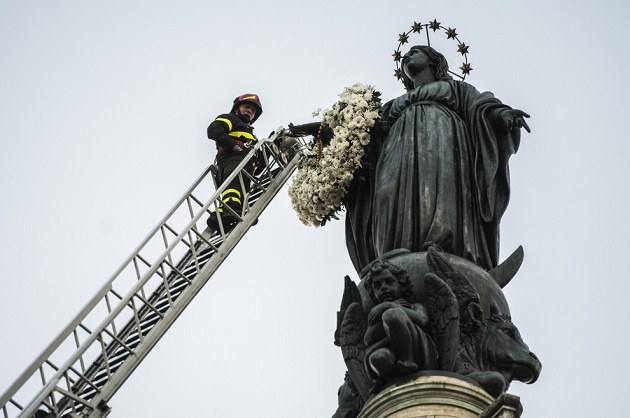Protestants find it difficult to come to terms with this Marian dogma. This is due to not finding even a hint of evidence for this belief in the Bible.
 Floral offering to the statue of Mary in the Piazza di Spagna (Rome). / Meridiana Notizie
Floral offering to the statue of Mary in the Piazza di Spagna (Rome). / Meridiana Notizie
On December 8th each year, the solemnity of the Immaculate Conception of Mary is celebrated. On this occasion the Roman Catholic Church contemplates the belief that Mary was preserved from original sin.
This view had been part of Roman Catholic teaching and devotional practices for centuries, but it was not until 1854 that the Immaculate Conception was officially promulgated by Pope Pius as a dogma, i.e. a binding and un-reformable belief of the Church. Here is the precise wording of this dogma:
“We declare, pronounce and define that the doctrine which asserts that the Blessed Virgin Mary, from the first moment of her conception, by a singular grace and privilege of almighty God, and in view of the merits of Jesus Christ, Saviour of the human race, was preserved free from every stain of original sin is a doctrine revealed by God and, for this reason, must be firmly and constantly believed by all the faithful”.
In spite of the bold and conclusive language (declaring, defining, asserting), Protestants find it difficult to come to terms with this Marian dogma. This is due to not finding even a hint of evidence for this belief in the Bible. “How can such a view be elevated to dogmatic status if the Word of God is at best silent on it?” they ask. So it is always interesting to listen to the way in which Roman Catholic theology argues for the Immaculate Conception of Mary by trying to relate it to Scriptural teaching.
Marian Solemnity
The last occasion for this was given by Pope Francis on December 8th. He spoke twice on the topic. The first was to a public audience in St. Peter’s square. He later spoke at a Marian prayer gathering in Piazza di Spagna, where a lofty statue of Mary towers above the space and where at the climax of the ceremony it is crowned with flowers. The Papal invocations to Mary appealed to her “immaculate heart” to learn how to love, to her “immaculate hands” to learn how to caress, to her “immaculate feet” to learn how to take the first step.
The special Marian day of the Pope also included a visit to the Roman Basilica of St. Mary Major to venerate the ancient “Salus Popoli Romani” (health or salvation of the Roman people) icon of Mary. The Pope travels to the basilica before and after every international trip he takes in order to entrust the voyage to the care and intercession of Mary, typically with flowers in hand. This is to say that we are not confronted with a marginal belief, nor with a peripheral practice. Both the dogma and the devotions attached to it are encapsulated at the very core of the Pope’s spirituality.
No Space For Sin?
In his speech, the Pope argued that “Jesus didn’t come as an adult, already strong and full grown, but decided to follow the exact same path of the human being, doing everything in exactly the same way “except for one thing: sin.” Because of this, “he chose Mary, the only creature without sin, immaculate,” he said, noting that when the angel refers to Mary with the title “Full of Grace,” it means that from the beginning there was “no space for sin” inside of her. “Also we, when we turn to her, we recognize this beauty: we invoke her as ‘full of grace,’ without the shadow of evil.”
It appears that the biblical reference the Pope recalls is Luke 1:28, where Mary is addressed by the angel Gabriel as a “favored” one. The Vulgate, the late fourth-century Latin version of the Bible, translates this expression as “gratia plena” (full of grace), thus opening up all sorts of misconceptions, as if Mary possessed the fullness of grace in herself. This translation has been taken as implying that she was so full of grace that she must have been conceived without original sin. However, there is no hint in the text about the fact that Mary is “full” of grace and therefore “void” of sin. Being “favored” indicates that she is an unworthy recipient of God’s grace, just as the rest of us. This is further reinforced by the fact that Mary calls God her “Savior” (Luke 1:47), indicating that she thinks of herself as needing God’s salvation, just as the rest of us. There is nothing intrinsic in her apart from the divine favor and His presence with her. It seems, therefore, that a strong argument for the Immaculate Conception of Mary is based on a faulty translation of the passage, leading to an implausible doctrine impinging on anthropology and soteriology, i.e. something belonging to the core of the biblical Gospel.
The fact that the Roman Catholic Church is fully committed to the Immaculate Conception of Mary still represents a serious question mark for all those who want to ground their faith in what the Bible teaches.
Evidently Rome is not based on Scripture alone but is on a trajectory in which devotions and traditions can have the final say above (and contrary to) the Bible.
Leonardo De Chirico, theologian, evangelical pastor and Director of the Reformanda Initiative.

Las opiniones vertidas por nuestros colaboradores se realizan a nivel personal, pudiendo coincidir o no con la postura de la dirección de Protestante Digital.
Si quieres comentar o